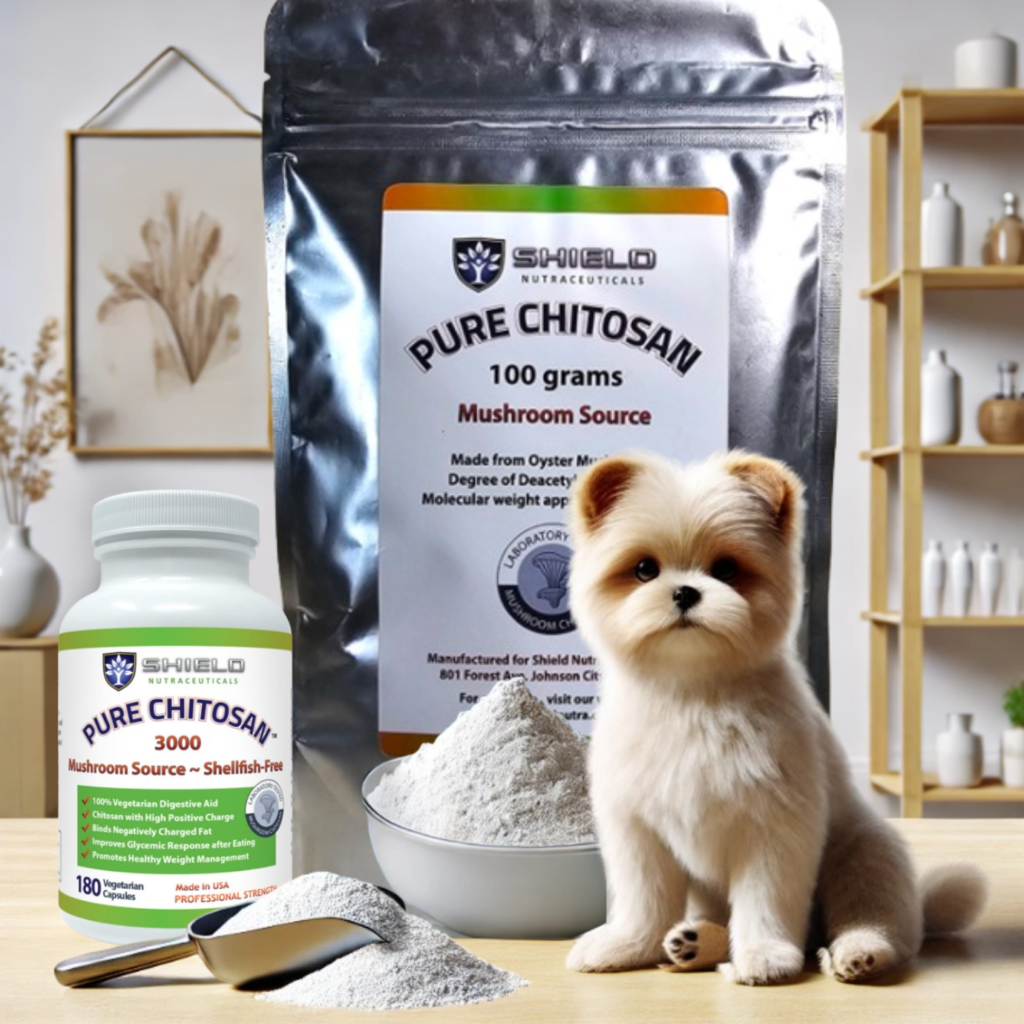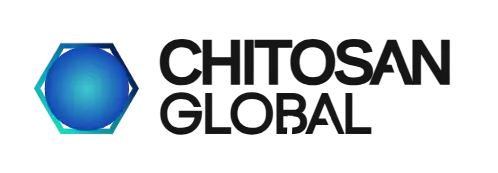How Quaternary Chitosan Transforms Disinfection in InstitutionsChitosan – A Breakout Biopolymer for Bioplastics and Bacteriostatic Stretch Films

What is Chitosan? Chitosan is pronounced, “Kite’-O-San”. It is a natural biopolymer derived from chitin, the structural component that gives mushrooms their rigidity and form, crustaceans their outer shell, and insects their exoskeleton. Origin and Abundance Chemical Structure and Properties Chitosan is obtained through a process called deacetylation of chitin. Deacetylation: Pronounced “dee-a-SETTLE-ay-shun” (emphasis on “dee”) This involves: Removing acetyl groups (CH3OH) from the chitin molecule Acetyl: Pronounced “A-see-tl” (emphasis on “see”) Creating a polymer with free amine groups (NH2) Amine: Pronounced a-MEEN This chemical transformation gives chitosan its positive charge, differentiating it from its parent compound, chitin. Solubility: Unlike chitin, chitosan is soluble in acidic to neutral solutions, making it more versatile for various applications. Our food grade mushroom chitosan oligosaccharide is soluble in water at any pH. It is bactericidal at pH 6.4 and below. To purchase wholesale, click HERE Biocompatibility and Biodegradability: Chitosan is known for its excellent biocompatibility and biodegradability. It’s non-toxic and can be broken down by natural biological processes. Uses and Applications: Chitosan, a versatile biopolymer derived from chitin, has found widespread applications across multiple industries due to its unique properties. This biodegradable and non-toxic compound offers a range of benefits in various sectors: Healthcare and Pharmaceuticals: Chitosan’s biocompatibility makes it invaluable in medical applications. It is used in wound healing products, drug delivery systems, and as a biomaterial in tissue engineering. Its ability to promote healing and control drug release has made it a popular choice in the pharmaceutical industry. Environmental Protection: In water treatment, chitosan’s capacity to bind with heavy metals and other contaminants makes it an effective agent for purification processes. This property has led to its use in both industrial and municipal water treatment facilities. Agriculture: Farmers and agronomists utilize chitosan as a natural biostimulant and elicitor. It enhances plant growth and boosts resistance against pathogens, contributing to more sustainable agricultural practices. Food Industry: Chitosan serves multiple purposes in food production and preservation. It acts as an antimicrobial food additive and can be used to create edible films or coatings that extend the shelf life of perishable products. Beverage Production: In the alcoholic beverage industry, chitosan is employed for clarification of wines, beers, and whiskeys, helping to improve their clarity and stability. Dietary Supplements: The compound is also used in the production of dietary supplements, capitalizing on its potential health benefits. Plastics Industry: Chitosan’s biodegradable nature makes it an attractive option for developing eco-friendly plastic alternatives. The wide-ranging applications of chitosan stem from its unique combination of biocompatibility, biodegradability, non-toxicity, and positive charge. What are the benefits & functions of mushroom chitosan when combined with PLA (Polylactic Acid)? Chitosan, sourced from mushrooms, offers several interesting benefits and functions when incorporated into polylactic acid (PLA) formulas. PLA is a biodegradable polymer derived from renewable sources such as corn starch or sugarcane, commonly used in bioplastics. Here’s how mushroom chitosan can enhance PLA: Polylactic acid (PLA) is a widely used bioplastic derived from renewable resources like corn starch or sugarcane. While PLA is biodegradable, its degradation rate in natural environments can be slow. Chitosan, a natural polymer derived from crustacean shells, has been found to enhance the biodegradability of PLA when used as a composite material. Benefits of Chitosan-PLA Composites Improved Biodegradation: Chitosan can accelerate the degradation process of PLA, making the composite more eco-friendly by improving its biodegradability in natural environments. Reduced Environmental Impact: By enhancing the biodegradability of PLA, chitosan-PLA composites can help reduce the accumulation of plastic waste in landfills and oceans. Potential Applications: Chitosan-PLA composites can be used in various applications, such as packaging materials, disposable utensils, and agricultural mulch films, where biodegradability is a desirable feature. Mechanism of Biodegradation Enhancement Chitosan, being a natural polymer, is susceptible to enzymatic degradation by microorganisms in the environment. When chitosan is incorporated into PLA, it creates a more porous structure that allows for better penetration of enzymes and microorganisms. This increased surface area and accessibility facilitate the breakdown of the composite material, leading to faster biodegradation compared to pure PLA. Factors Affecting Biodegradation Rate The biodegradation rate of chitosan-PLA composites can be influenced by various factors, such as: Chitosan content: Higher concentrations of chitosan in the composite generally result in faster biodegradation. Molecular weight of chitosan: Lower molecular weight chitosan tends to degrade more quickly, leading to faster biodegradation of the composite. Environmental conditions: Temperature, humidity, and the presence of specific microorganisms can affect the rate of biodegradation in natural environments. Environmental Benefits of Chitosan-PLA Composites Reduced Carbon Footprint Chitosan-PLA composites contribute to a lower carbon footprint compared to traditional petroleum-based plastics. This reduction is primarily due to: Renewable Sourcing: Both materials are obtained from renewable resources. PLA is typically derived from corn starch or sugarcane, while chitosan is extracted from crustacean shells, a byproduct of the seafood industry. Biodegradability: The enhanced biodegradability of these composites means they break down more quickly in natural environments, releasing less greenhouse gases over time compared to persistent synthetic plastics. Energy Efficiency: The production of chitosan-PLA composites often requires less energy compared to the manufacturing of conventional plastics, further reducing their overall carbon footprint. Decreased Reliance on Fossil Fuels By utilizing renewable resources, chitosan-PLA composites help decrease dependence on fossil fuels: Resource Conservation: The use of agricultural and marine byproducts as raw materials conserves non-renewable petroleum resources. Circular Economy: These materials promote a more circular economy by repurposing waste products (like crustacean shells) into valuable
Chitosan for Eco-responsible Dust Suppression

What is Chitosan? Chitosan is a natural biopolymer extracted from fungi, insect shells, shellfish, bacteria, and algae. It’s derived from chitin, a structural component that provides rigidity and form. Origin and Abundance Pronunciation Guide Chemical Structure and Properties Chitosan is obtained through a process called deacetylation of chitin. This involves: This chemical transformation gives chitosan its positive charge, differentiating it from its parent compound, chitin. What are the benefits of chitosan in dust suppression? Chitosan serves as an effective ingredient in dust suppressants due to its unique properties and environmental benefits. Here’s a breakdown of its benefits and functions: Benefits of Chitosan in Dust Suppressants: Functions of Chitosan in Dust Suppressants: Chitosan offers a natural, effective, and environmentally sustainable solution for dust suppression across various sectors. What common forms of chitosan are used in dust suppression? Chitosan can be used in various forms when applied as a dust suppressant, each suitable for different environments and application methods. The addition ratios and suitable applications for each form of chitosan, as a dust suppressant, vary based on the specific product formulation and the environmental conditions of the application site. Here are some of the common forms, along with general guide on how these might typically be configured: Each form of chitosan offers specific advantages depending on the application requirements, such as the area size, the nature of the surface, and the expected duration of dust suppression needed. In all cases, the specific formulation and application methods should be adjusted based on local environmental regulations, the specific type of dust to be controlled, and the characteristics of the site (e.g., soil type, weather conditions, and area size). It’s often beneficial to consult with a specialist or refer to technical data sheets provided by the chitosan manufacturer to determine the optimal usage and mixing ratios. Which types of chitosan are suitable for each form of dust suppression? The type of chitosan suitable for each form of dust suppressant depends on the desired solubility, viscosity, and specific application needs. Here’s a breakdown of how each type of chitosan is typically used: Each type of chitosan has specific properties that make it more or less suitable for certain applications. When selecting a chitosan type, consider the environmental pH, the method of application, and the specific needs of the area being treated (such as the need for rapid action or long-lasting effects). Consulting with a product specialist or manufacturer can also help tailor the choice to the specific conditions and requirements of the dust suppression project. Chitosan in Dust Suppression – Notes In the quest for sustainable environmental solutions, chitosan emerges as a game-changer in dust control. This innovative substance perfectly balances effectiveness with ecological responsibility, setting a new standard in the industry. Powerful and Natural Chitosan’s strength lies in its natural origins. Derived from sustainable sources, it demonstrates exceptional dust-binding capabilities, effectively tackling airborne pollution and significantly improving air quality. Its ability to capture and hold dust particles makes it a formidable ally in the fight against environmental contamination. Environmentally Friendly and Versatile What sets chitosan apart is its impressive environmental profile: These qualities make chitosan an ideal choice for a diverse range of settings: A Healthier Future By choosing chitosan for dust suppression, we’re not just controlling dust – we’re investing in a healthier planet. Its non-toxic nature ensures that both human communities and wildlife can thrive, creating a safer and cleaner environment for all.Chitosan represents more than just a dust control solution; it’s a step towards a more sustainable and responsible approach to environmental management. As we face growing environmental challenges, innovations like chitosan offer hope for a cleaner, greener future. Integrating chitosan into dust control strategies offers a multifaceted approach to environmental management. This versatile compound not only mitigates the pervasive issue of airborne dust but also enhances soil moisture retention, creating an environment conducive to robust plant growth and improved soil stability. One of chitosan’s key strengths lies in its adaptability. Available in various forms—from liquid solutions and gels to powders and pellets—it can be tailored to meet the unique demands of diverse landscapes and industrial settings. This flexibility ensures that whether you’re dealing with a busy highway, a delicate ecosystem, or a complex industrial site, there’s a chitosan-based solution to fit your needs. The applications of chitosan in dust suppression are far-reaching: As a naturally derived substance with powerful dust-binding properties, chitosan is revolutionizing dust management practices. Its adoption represents a significant step towards more sustainable environmental stewardship, promising clearer skies and healthier ecosystems for future generations.By embracing chitosan-based solutions, we’re not just controlling dust—we’re cultivating a cleaner, greener world. Book a Free Consultation If you don’t know what type of chitosan is best for your situation, Book an appointment. we will offer you an initial 30-minute consultation and product quotation at no charge.
Green Breakthrough in Papermaking: The Rising Role of Mushroom Chitosan for Sustainable Production

Did you say Mushroom Chitosan? Mushroom chitosan is a natural biopolymer extracted from the cell walls of fungi. It comes from chitin, a structural component that gives mushrooms their rigidity and form. Origin and Abundance Pronunciation Guide Chemical Structure and Properties Chitosan is obtained through a process called deacetylation of chitin. This involves: This chemical transformation gives chitosan its positive charge, differentiating it from its parent compound, chitin. Medical and Pharmaceutical Innovations Chitosan’s biocompatibility has revolutionized healthcare applications. Its use spans: The compound’s ability to accelerate healing and regulate drug release has solidified its position in the pharmaceutical industry. 1 Environmental Remediation In the realm of water treatment, chitosan excels due to its affinity for: This characteristic has led to its adoption in both industrial and municipal water purification facilities, contributing to cleaner water resources. Agricultural Advancements Farmers and agricultural experts harness chitosan’s potential as: These properties foster more sustainable farming practices by enhancing crop growth and resilience. Food Technology In food production and preservation, chitosan serves multiple roles: These applications significantly extend the shelf life of perishable goods, reducing food waste. Beverage Industry Applications Chitosan plays a crucial role in alcoholic beverage production, particularly in: Its use enhances the clarity and stability of these products, improving their overall quality. Nutritional Supplements The compound has found its way into the dietary supplement market, leveraging its potential health benefits to create new product lines. Sustainable Materials Development In the plastics industry, chitosan’s biodegradable nature positions it as a promising candidate for developing eco-friendly alternatives to conventional plastics, aligning with global sustainability goals. Through these diverse applications, chitosan continues to demonstrate its significance as a versatile and sustainable resource across multiple industries. The wide-ranging applications of chitosan stem from its unique combination of biocompatibility, biodegradability, non-toxicity and positive charge. Mushroom Chitosan is a type of chitosan derived from the cell walls of fungi. It has several advantages over traditional chitosan derived from shellfish, including: Overall, mushroom chitosan offers several advantages over traditional chitosan, making it an attractive alternative for individuals and industries looking for a vegan, allergen-free, and more effective chitosan source. What are the Benefits of Chitosan in the Paper Industry? Fungal chitosan, sourced from non-animal origins such as mycelium and mushrooms, is revolutionizing the paper industry by offering an eco-friendly alternative to traditional chemicals. Here are the benefits and functions of chitosan in paper industry: Benefits of Chitosan in the Paper Industry Chitosan as a paper strengthening agent in the paper industry: Fiber Bonding Enhancement: Chitosan improves the bonding between paper fibers, leading to increased mechanical strength of the paper. The positively charged amino groups in chitosan interact with the negatively charged surfaces of cellulose fibers, creating electrostatic bonding. Mechanical Properties Improvement: Addition of chitosan can significantly improve tensile strength, burst strength, and tear resistance of paper. For example, one study found that chitosan increased the tensile index, tearing index, and burst index of paper by 71.5%, 31.7%, and 79.1% respectively at a 3.0 g/m2 coating weight. Wet Strength Enhancement: Chitosan notably improves the wet strength of paper, which is crucial for many applications. One study reported that chitosan coating increased the wet strength of paper by 4.4 to 6.5 times compared to untreated paper. Flexibility Improvement: Chitosan can enhance the flexibility of paper, making it less brittle and more suitable for various applications. Additive Versatility: Chitosan can be used as both a wet-end additive and a surface coating agent in papermaking. As a wet-end additive, it can be mixed directly with the pulp before sheet formation. As a coating, it can be applied to the surface of formed paper sheets. Concentration Effects: The strengthening effects of chitosan are typically observed at relatively low concentrations, often in the range of 1-5% by weight. Synergistic Effects: Chitosan can be combined with other additives like nanofibrillated cellulose (NFC) to further enhance paper properties. Environmental Benefits: As a biodegradable and renewable material, chitosan aligns with the paper industry’s sustainability goals. Retention Aid: It helps in improving the retention of fine particles and fillers during the papermaking process. This leads to better efficiency and reduced costs by minimizing waste of raw materials. Sizing Agent: Chitosan can be used as a sizing agent to improve the water resistance of paper. This is particularly useful in making paper suitable for various printing and packaging applications where moisture resistance is necessary. Flocculant: In wastewater treatment processes within the paper mills, chitosan acts as a flocculant, aiding in the aggregation and removal of suspended solids, which clarifies the water and enhances the effectiveness of the wastewater treatment system. Antimicrobial Agent: Exploiting its antimicrobial properties, chitosan is used in papers that require a sterile environment, providing an inhibitory surface against microbial growth, thus extending the shelf life and usability of paper products in sensitive applications. What are the common forms of vegetal chitosan in paper industry? In the paper industry, vegetal chitosan, derived from sources like mushrooms, fungi, or other non-animal origins, is typically utilized in a few common forms to suit various applications. The addition ratio of chitosan in paper production can vary widely depending on the desired properties of the final product and the specific form of chitosan used. Here’s a general guide on how each form is typically used and its suitable applications: Powder: Chitosan powder is the most common form used in the paper industry. It is easily dispersed in water and can be directly applied during the paper manufacturing process. The powder form allows for precise dosage and consistent distribution throughout the paper pulp. Adding Ratio: Typically, 0.5% to 3% of the dry paper pulp weight. Suitable Applications: Used across a wide range of paper products, including printing and writing papers where strength and durability are needed. It is also used in specialty papers like antibacterial or food contact papers. Flakes: Similar to powder, chitosan flakes are another dry form of chitosan that can be used in paper production. Flakes might require additional processing, such as dissolution in acidic solutions, before they can be integrated
Green Luxury: How Mushroom Chitosan is Redefining Bio-Leather for the Eco-Conscious Market

What is Mushroom Chitosan? Mushroom chitosan is a natural biopolymer extracted from the cell walls of fungi. It’s derived from chitin, a structural component that gives mushrooms their rigidity and form. Origin and Abundance Pronunciation Guide Chemical Structure and Properties Chitosan is obtained through a process called deacetylation of chitin. This involves: This chemical transformation gives chitosan its positive charge, differentiating it from its parent compound, chitin. Uses and Applications: Chitosan, a versatile biopolymer derived from chitin, has found widespread applications across multiple industries due to its unique properties. This biodegradable and non-toxic compound offers a range of benefits in various sectors: The wide-ranging applications of chitosan stem from its unique combination of biocompatibility, biodegradability, non-toxicity and high positive charge. Variants: Chitosan’s versatility, biodegradability, and non-toxic nature make it a valuable material across various industries, from healthcare to cosmetics. Its ability to be derived from non-animal sources also makes it an appealing option for vegetarian and vegan-friendly products. What are the advantages of Mushroom Chitosan? Mushroom Chitosan is a type of chitosan derived from the cell walls of fungi. It has several advantages over traditional chitosan derived from shellfish, including: Mushroom chitosan offers several advantages over traditional chitosan, making it an attractive alternative for individuals and industries looking for a vegan, allergen-free, and more effective chitosan source. What are the benefits and functions of mushroom chitosan in bio-leather? Mushroom chitosan is revolutionizing the production of bio-leather through its impressive array of benefits and functional advantages. This breakthrough material combines eco-friendliness with advanced performance features, making it an ideal choice for sustainable manufacturing. Here’s a detailed overview of its key benefits and functions: 1. Eco-Friendly and Sustainable Mushroom chitosan is derived from renewable fungal sources, making it an environmentally responsible alternative to traditional leather Its biodegradability ensures minimal environmental impact, as products made from it will break down naturally at the end of their lifecycle 2. Reduced Environmental Impact The production of mushroom chitosan eliminates the need for toxic chemicals typically used in traditional leather tanning and finishing This shift protects ecosystems and the health of workers involved in the manufacturing process. 3. Versatility Mushroom chitosan can be tailored for use in a variety of bio-leather products, from high-fashion items to durable upholstery This adaptability opens up new possibilities for designers and manufacturers in the sustainable luxury market. Functions of Mushroom Chitosan in Bio-Leather 1. Structural Enhancement Incorporating mushroom chitosan into bio-leather significantly improves its physical robustness The material becomes more resistant to wear and tear, ensuring longevity and durability in everyday use. 2. Antimicrobial Properties The inherent antimicrobial activity of chitosan contributes to a longer lifespan for bio-leather products by preventing microbial degradation and odor This natural resistance makes chitosan-enhanced bio-leather ideal for applications where hygiene is paramount. 3. Moisture Management Mushroom chitosan enhances the water-resistance of bio-leather, protecting against moisture-induced damage This function is vital for maintaining the structural integrity and aesthetic quality of leather goods across different climates and conditions. By harnessing these properties, mushroom chitosan enables the creation of bio-leather that not only serves as a viable alternative to traditional leather but also aligns with environmental ethics and consumer demands for sustainability and performance. The use of mushroom chitosan in bio-leather production indeed offers significant environmental benefits compared to traditional leather tanning processes. Here’s a detailed look at how it reduces environmental impact: Elimination of Toxic Chemicals Traditional leather tanning relies heavily on a cocktail of harmful chemicals, including chromium salts, formaldehyde, and various synthetic tanning agents. These substances can have severe environmental consequences: Water pollution: Tannery effluents often contaminate local water sources, affecting aquatic ecosystems and human health. Soil contamination: Chemical runoff can degrade soil quality, impacting agriculture and biodiversity. Air pollution: Volatile organic compounds (VOCs) released during tanning contribute to air quality issues. In contrast, mushroom chitosan-based bio-leather production eliminates the need for these toxic chemicals, significantly reducing the risk of environmental contamination. Ecosystem Protection By avoiding the use of harmful substances, mushroom chitosan helps preserve local ecosystems: Aquatic life: Rivers and streams near traditional tanneries often suffer from chemical pollution, leading to fish die-offs and disrupted aquatic food chains. Chitosan-based processes help maintain the health of these water bodies. Soil health: The absence of chemical runoff means surrounding soil remains fertile and capable of supporting diverse plant and animal life. Biodiversity: Reduced pollution helps maintain the delicate balance of local ecosystems, protecting various species that might otherwise be affected by traditional tanning processes. Worker Health and Safety The shift to mushroom chitosan also has significant implications for worker health: Reduced exposure to carcinogens: Many chemicals used in traditional tanning, such as chromium compounds, are known carcinogens. Eliminating these substances greatly reduces the risk of occupational cancers. Improved respiratory health: Workers in traditional tanneries often suffer from respiratory issues due to exposure to chemical fumes. Chitosan-based processes significantly reduce this risk. Skin protection: Direct contact with tanning chemicals can cause severe skin irritation and long-term health issues. Mushroom chitosan is much gentler on the skin, improving overall worker safety. Sustainable Resource Use Unlike traditional leather, which relies on animal hides and resource-intensive cattle farming, mushroom chitosan can be produced from agricultural waste or purpose-grown fungi. This approach: Reduces land use pressure: It doesn’t require vast tracts of land for grazing animals. Lowers water consumption: Mushroom cultivation typically requires less water than raising cattle for leather. Decreases carbon footprint: The overall process of producing mushroom chitosan generally has a lower carbon footprint compared to traditional leather production. By addressing these critical environmental and health concerns, the use of mushroom chitosan in bio-leather production represents a significant step towards more sustainable and ethical manufacturing practices in the textile industry. Consumer Safety and Hypoallergenic Advantages of Mushroom Chitosan in Bio-Leather Mushroom chitosan offers compelling benefits for bio-leather products, particularly appealing to health-conscious consumers and those with sensitivities. This innovative material presents several advantages over traditional leather and synthetic alternatives: Natural Hypoallergenic PropertiesUnlike conventional leather or synthetic materials that
Chitosan for Bio-Packaging – Bacteriostatic and Non-Toxic

Why is everybody talking about Chitosan? Chitosan is a natural biopolymer made from extracting chitin from the cell walls of fungi, the shells of crustaceans and insects, and some forms of algae. Chitin is the structural component that gives mushrooms their rigidity and form. It holds them up. We like mushroom chitosan for any application where chitosan is being ingested by a living creature. Origin and Abundance – more about chitin Pronunciation Guide Chemical Structure and Properties Chitosan is obtained through a process called deacetylation of chitin. This involves: This chemical transformation gives chitosan its positive charge, differentiating it from its parent compound, chitin. Solubility: Unlike chitin, chitosan is soluble in acidic to neutral solutions, making it more versatile for various applications. Our food grade mushroom chitosan oligosaccharide is soluble in water at any pH. It is bactericidal at pH 6.4 and below. To purchase wholesale, click HERE Uses and Applications: Chitosan, a versatile biopolymer derived from chitin, has found widespread applications across multiple industries due to its unique properties. This biodegradable and non-toxic compound offers a range of benefits in various sectors: Healthcare and Pharmaceuticals: Chitosan’s biocompatibility makes it invaluable in medical applications. It is used in wound healing products, drug delivery systems, and as a biomaterial in tissue engineering. Its ability to promote healing and control drug release has made it a popular choice in the pharmaceutical industry. Environmental Protection: In water treatment, chitosan’s capacity to bind with heavy metals and other contaminants makes it an effective agent for purification processes. This property has led to its use in both industrial and municipal water treatment facilities. Agriculture: Farmers and agronomists utilize chitosan as a natural biostimulant and elicitor. It enhances plant growth and boosts resistance against pathogens, contributing to more sustainable agricultural practices. Food Industry: Chitosan serves multiple purposes in food production and preservation. It acts as an antimicrobial food additive and can be used to create edible films or coatings that extend the shelf life of perishable products. Beverage Production: In the alcoholic beverage industry, chitosan is employed for clarification of wines, beers, and whiskeys, helping to improve their clarity and stability. Dietary Supplements: The compound is also used in the production of dietary supplements, capitalizing on its potential health benefits. Plastics Industry: Chitosan’s biodegradable nature makes it an attractive option for developing eco-friendly plastic alternatives. The wide-ranging applications of chitosan stem from its unique combination of biocompatibility, biodegradability, and non-toxicity. Variants: Traditional Chitosan: Traditionally sourced from marine crustaceans, insect larvae, Aspergillus Niger Mushroom Chitosan: Derived from fungal sources, offering an alternative for those seeking non-animal derived products Chitosan’s versatility, biodegradability, and non-toxic nature make it a valuable material across various industries, from healthcare to cosmetics. Its ability to be derived from non-animal sources also makes it an appealing option for vegetarian and vegan-friendly products. What are the advantages of Mushroom Chitosan? Mushroom Chitosan is a type of chitosan derived from the cell walls of fungi. It can also be created from Mycelium. It has several advantages over traditional chitosan derived from shellfish, including: 1. Vegan and vegetarian-friendly: Mushroom chitosan is an excellent alternative for individuals who avoid animal-based products, such as those who follow a vegan lifestyle. 2. Allergen-free: Traditional chitosan is derived from shellfish, which can cause allergic reactions in some people. Mushroom chitosan does not contain any shellfish-derived ingredients, making it an allergen-free option. 3. Purer: Mushroom chitosan is often considered to be purer than traditional chitosan because it is derived from a single source, whereas traditional chitosan can be contaminated with other shellfish-related substances. 4. Better solubility: Fungal chitosan is more soluble than traditional chitosan, which makes it easier to incorporate into a variety of applications such as cosmetics, bioplastics, wound care and food. 5. Improved bioavailability: Some studies have suggested that mushroom chitosan has higher bioavailability compared to traditional chitosan, which means that it can be absorbed and utilized more effectively by the body. Overall, mushroom chitosan offers several advantages over traditional chitosan, making it an attractive alternative for individuals and industries looking for a vegan, allergen-free, and more effective chitosan source. What are the benefits & functions of chitosan in bio-packaging? Chitosan, derived from sources like mushrooms or mycelium, offers a variety of benefits and functions in the field of bio-packaging. Here are some details: Biodegradability: Chitosan is fully biodegradable, reducing pollution compared to conventional plastic packaging. The time is now to create new factories to make bioplastic from chitosan and hemp! Check out our article on bioplastics here. Non-Toxicity: Derived from natural sources, chitosan is biocompatible, biodegradable, non-toxic and safe for use in food packaging. It poses no harm to consumers or the environment. Antimicrobial Properties: Due to its positive charge, Chitosan has inherent antimicrobial properties that help extend packaged food’s shelf life. Through electrostatic action, chitosan inhibits the growth of bacteria. Barrier Properties: It provides excellent barrier properties against oxygen and oils, crucial for maintaining the quality and freshness of food products. 1 Compatibility with Other Materials: Chitosan can be easily combined with other biopolymers such as hemp, enhancing the mechanical and barrier properties of the resulting bio-packaging materials. 2 Functions of Chitosan in Bio-Packaging Food Preservation: Utilizes its antimicrobial and antifungal properties to preserve the quality and extend the shelf life of perishable goods, such as fruits, vegetables, and meats. 3 Edible Coatings: Chitosan an be used to create edible films or coatings that directly adhere to the surface of food products, offering additional protection against spoilage and physical damage. Measured Release of Additives: Chitosan films can be micelized to deliver functional additives like antioxidants, terpenes, esters, flavonoids, polyphenols, and nutrients, which can be released in a controlled manner to improve food quality and safety. Water Vapor Barrier: Chitosan films can act as barriers to water vapor, helping to maintain the desired moisture content of food products such as bakery items, fruits and vegetables. Environmental Impact Reduction: By replacing plastics with biocompatible, biodegradable chitosan-based materials, the environmental impact of packaging waste can be significantly reduced. 4 The use of chitosan in bio-packaging is a promising development in sustainable packaging solutions, offering
Nature’s Newest Tools: Chitosan’s Value in Advanced Wound Care

Chitosan Origin and Abundance Pronunciation Guide Chemical Structure and Properties Chitosan is obtained through a process called deacetylation of chitin. This involves: This chemical transformation gives chitosan its positive charge, differentiating it from its parent compound, chitin. Uses and Applications: Chitosan: A Versatile Biopolymer Revolutionizing Multiple Industries Chitosan, a remarkable biopolymer derived from chitin, has emerged as a game-changing substance across various sectors. Its unique properties, combined with its biodegradability and non-toxicity, have led to its widespread adoption in numerous applications. 1. Healthcare and Pharmaceuticals Chitosan’s biocompatibility has made it a cornerstone in medical innovations: 2. Environmental Protection In the realm of environmental conservation, chitosan plays a crucial role: 3. Agriculture Farmers and agronomists leverage chitosan’s properties to enhance crop production: 4. Food Industry Chitosan’s versatility extends to food production and preservation: 5. Beverage Production In the alcoholic beverage sector, chitosan serves multiple purposes: 6. Dietary Supplements The health benefits of chitosan have led to its inclusion in various supplements: 7. Plastics Industry As sustainability becomes increasingly important, chitosan offers eco-friendly alternatives: By harnessing the power of this versatile biopolymer, industries are not only improving their products and processes but also contributing to more sustainable practices across the board. As research continues, it’s likely that even more applications for chitosan will be discovered, further cementing its status as a truly revolutionary material. The wide-ranging applications of chitosan stem from its unique combination of biocompatibility, biodegradability, and non-toxicity. As research continues, it’s likely that even more uses for this versatile compound will be discovered across various industries. There are over 3000 new articles being published about chitosan every year! Variants: Chitosan’s versatility, biodegradability, and non-toxic nature make it a valuable material across various industries, from healthcare to cosmetics. Its ability to be derived from non-animal sources also makes it an appealing option for vegetarian and vegan-friendly products. What are the advantages of Mushroom Chitosan? Mushroom Chitosan is a type of chitosan derived from the cell walls of fungi. It has several advantages over traditional chitosan derived from shellfish, including: Overall, mushroom chitosan offers several advantages over traditional chitosan, making it an attractive alternative for individuals and industries looking for a vegan, allergen-free, and more effective chitosan source. What are the benefits & functions of chitosan in wound care? Fungal chitosan, derived from sources like oyster mushrooms and Aspergillus niger (from corn fermentation), has several benefits and functions in wound care. Here’s a breakdown: Chitosan for Wound Care Functions of Chitosan in Wound Care Chitosan offers a unique combination of benefits and functions that make it highly suitable for wound care applications. Its ability to promote healing and prevent infection while being biocompatible and biodegradable aligns well with the needs of effective wound management. What the common forms of chitosan used in wound care? Chitosan can be processed into several forms for use in wound care, each suited to different types of wounds and treatment goals. Creating formulations using mushroom or mycelium-based chitosan for wound care products involves carefully balancing the amount of chitosan with other ingredients to achieve the desired properties such as gel strength, flexibility, absorbency, and antimicrobial activity. Here are some of the most common forms and formulations for each type of chitosan-based product used in wound care, including ratios: Each of these forms leverages the inherent properties of chitosan, such as biocompatibility, antimicrobial activity, and biodegradability, making them highly effective in various aspects of wound care. 3 General Tips for Formulation These guidelines provide a basic framework for developing chitosan-based wound care products, but detailed formulation development would require experimental validation and regulatory compliance checks, particularly for products intended for medical use. Additional Considerations for Chitosan Types to Choose The selection of the type of chitosan for each form of wound care product is critical, as the chemical modifications and physical properties of different chitosan derivatives can greatly influence the effectiveness, usability, and comfort of the final product. Choosing the right type of chitosan is crucial for maximizing the effectiveness of the wound care product, and these choices should be guided by the specific application needs, desired properties of the final product, and the patient’s comfort and safety. Each chitosan derivative brings unique properties that can be leveraged in different forms of wound care products. Discussion of chitosan in wound care Chitosan, derived from sources like oyster mushrooms and Aspergillus niger, has emerged as a highly effective material for wound care applications due to its biocompatibility, biodegradability, and intrinsic antimicrobial properties. Its ability to form films, gels, foams, fibers, sponges, and particles or powders makes it extremely versatile in addressing different types of wounds. Chitosan facilitates rapid hemostasis, accelerates tissue regeneration by promoting collagen synthesis and granulation tissue formation, and helps manage wound exudates through its superior moisture-absorbing capabilities. These properties not only enhance the healing process but also reduce the risk of infection, making chitosan a valuable component in advanced wound care solutions. The use of chitosan in wound care is tailored through various formulations, depending on the specific needs of the wound environment. Chitosan gels are ideal for keeping wounds moist, while films provide a protective barrier. Foams and sponges are suited for highly exudative wounds, absorbing fluids and maintaining optimal conditions for healing. Fibers can be used to pack or wrap wounds, offering structural support. Each form of chitosan can be adjusted in terms of viscosity and concentration to optimize its effectiveness, demonstrating the adaptability and the potential of vegetal chitosan in improving wound management practices significantly. References: Book a Free Consultation If you don’t know what type of chitosan is best for your situation, Book an appointment. we will offer you an initial 30-minute consultation and product quotation at no charge.
Chitosan-A Vital New Ingredient in Novel Dental Care Products

Got Chitosan? Chitosan is a natural biopolymer extracted from the cell walls of fungi and the shells of crustaceans and insects. It’s derived from chitin, a structural component that gives mushrooms their rigidity and form. Origin and Abundance Pronunciation Guide Chemical Structure and Properties Chitosan is obtained through a process called deacetylation of chitin. This involves: This chemical transformation gives chitosan its positive charge, differentiating it from its parent compound, chitin. What are the benefits of using non-shellfish chitosan in dental & oral care? Mushroom chitosan derived from sources like oyster mushrooms, presents several beneficial properties for dental oral care. (We do not recommend EVER putting shellfish-derived chitosan in ANY products that contact humans or animals.) Here’s a list of its functions and benefits: Mushroom Chitosan in Dental/Oral Care Reduction of Dental Plaque and Periodontal Disease: Chitosan’s powerful antibacterial properties make it a formidable ally in the fight against oral health issues. By actively suppressing bacterial growth and breaking down stubborn biofilms, chitosan creates an inhospitable environment for harmful microorganisms in the mouth. This dual-action approach significantly reduces plaque formation on teeth and along the gum line, effectively lowering the risk of periodontal disease development. As a natural defender against oral pathogens, chitosan helps maintain a balanced oral microbiome, preventing the inflammation and tissue damage associated with gum disease. Its ability to penetrate and dismantle existing biofilms also makes chitosan an invaluable tool in combating persistent oral infections, offering a proactive solution for maintaining optimal dental health. Improved Wound Healing: Chitosan, a versatile biopolymer derived from chitin, exhibits remarkable properties that significantly enhance the healing process of oral tissues. Its unique ability to promote tissue regeneration accelerates the recovery of oral abrasions and surgical sites, leading to faster and more effective healing outcomes. This natural compound creates an optimal environment for cell proliferation and tissue repair, reducing inflammation and minimizing the risk of infection. As a result, patients experience quicker recovery times, less discomfort, and improved overall healing of oral wounds and post-surgical areas. The application of chitosan-based materials in dental procedures has thus become increasingly popular, offering promising advancements in oral health care and surgical recovery. Enhanced Efficacy of Oral Hygiene Products: Chitosan’s unique capacity to bind and gradually release therapeutic agents revolutionizes oral care products, significantly enhancing their efficacy. This remarkable property allows for extended protection against harmful oral pathogens, ensuring a longer-lasting defense for dental health. The integration of chitosan into toothpaste formulations is rapidly gaining traction in the dental care industry, with widespread adoption seemingly imminent. Forward-thinking companies are poised to capitalize on this innovation, as the market for chitosan-enhanced oral care products is set to expand dramatically. Savvy businesses should act swiftly to secure their share of this burgeoning market and stay ahead of the curve in dental hygiene advancements. Call us today. Safe and Natural Oral Care: Chitosan’s natural origins and remarkable properties make it an ideal candidate for revolutionizing oral hygiene products. As a biocompatible and biodegradable substance, it offers a safe and eco-friendly alternative to synthetic ingredients commonly found in dental care formulations. This natural polymer significantly reduces the risk of adverse reactions, making it particularly suitable for individuals with sensitive oral tissues or those prone to allergies. By incorporating chitosan into toothpaste, mouthwash, and other oral care products, manufacturers can create gentler yet highly effective solutions that promote optimal oral health without compromising on safety. This shift towards natural, body-friendly ingredients aligns perfectly with the growing consumer demand for safer and more sustainable personal care options. Anti-Inflammatory Properties: Chitosan’s anti-inflammatory properties make it a powerful ally in the fight against gum diseases. This natural compound has shown remarkable efficacy in reducing gum inflammation, offering a promising approach to both treating and preventing conditions such as gingivitis. By incorporating chitosan into oral care routines, individuals can potentially mitigate the swelling, redness, and discomfort associated with inflamed gums. Its ability to soothe irritated tissues and promote healing creates a healthier oral environment, potentially reducing the risk of more severe periodontal issues. As research continues to unveil chitosan’s benefits, it’s becoming increasingly clear that this versatile substance could play a crucial role in maintaining optimal gum health and supporting overall oral well-being. Functions of Mushroom Chitosan in Dental Oral Care Antimicrobial Activity: Chitosan of the proper molecular weight (3kDa) and degree of deacetylation (>98%) inhibit the growth and activity of various pathogens in the oral cavity, helping prevent infections and complications like tooth decay and gum disease. To buy chitosan in bulk at wholesale prices, go HERE Biofilm Disruption: The right derivative of Chitosan can disrupt the structure and formation of bacterial biofilms on dental surfaces, which are a major cause of plaque buildup and cavities. Call us today to discuss the right derivative for your application. Call 423-202-6145. Ask for Steve Nice Carrier for Therapeutic Agents: Chitosan’s versatility extends beyond its inherent benefits, as it excels as a carrier and delivery system for other active ingredients in dental products. This natural polymer creates a synergistic effect, enhancing the stability and potency of various oral care formulations. By encapsulating or binding to other beneficial compounds, chitosan facilitates their controlled release, ensuring a more sustained and targeted delivery within the oral cavity. This unique property allows for improved absorption and prolonged action of active ingredients, maximizing their therapeutic potential. As a result, dental products incorporating chitosan as a delivery medium can achieve greater efficacy, providing users with more comprehensive and long-lasting oral health benefits. This innovative approach to ingredient delivery is revolutionizing the development of advanced dental care solutions. Wound Healing Support: Chitosan’s remarkable ability to accelerate oral tissue healing makes it a valuable asset in post-dental surgery recovery and the treatment of mouth ulcers. This natural biopolymer stimulates and enhances cellular activities crucial for tissue regeneration, creating an optimal environment for rapid healing. By promoting cell proliferation and migration, chitosan helps to rebuild damaged oral tissues more efficiently. Its application can significantly reduce recovery times following dental procedures, alleviating discomfort and minimizing
Mushroom Chitosan in Hair Care: Enhanced Moisture, Strength, and Shine

What is Mushroom Chitosan? Mushroom chitosan is a natural biopolymer extracted from the cell walls of fungi. It’s derived from chitin, a structural component that gives mushrooms their rigidity and form. Origin and Abundance Pronunciation Guide Chemical Structure and Properties Chitosan is obtained through a process called deacetylation of chitin. This involves: This chemical transformation gives chitosan its positive charge, differentiating it from its parent compound, chitin. Uses and Applications: Chitosan, a versatile biopolymer derived from chitin, has found widespread applications across multiple industries due to its unique properties. This biodegradable and non-toxic compound offers a range of benefits in various sectors: The wide-ranging applications of chitosan stem from its unique combination of biocompatibility, biodegradability, non-toxicity and positive electrical charge. Variants: Chitosan’s versatility, biodegradability, and non-toxic nature make it a valuable material across various industries, from healthcare to cosmetics. Its ability to be derived from non-animal sources also makes it an appealing option for vegetarian and vegan-friendly products. What are the advantages of Mushroom Chitosan? Mushroom Chitosan is a type of chitosan derived from the cell walls of fungi. It has several advantages over traditional chitosan derived from shellfish, including: Mushroom chitosan offers several advantages over traditional chitosan, making it an attractive alternative for individuals and industries looking for a vegan, allergen-free, and more effective chitosan source. What are the benefits of chitosan in hair care? Chitosan is a natural biopolymer derived from the structural elements in the cell walls of fungi, making it a vegetarian alternative to traditional chitosan, which is sourced from shellfish. Chitosan and hair are complementary because they carry opposite electrical charges – Chitosan positive and hair negative . A Clear solution that contains chitosan forms a clear, elastic film on hair, increasing its softness and mechanical strength. The material can also form a gel when added to mixtures of alcohol and water. Chitosan acts as an antistatic thereby protecting hair from waving and bleaching agents. It helps to retain moisture in low humidity and to maintain hair’s style in high humidity. The material can be used in shampoos , rinses, permanent wave agents, hair colourants, styling lotions, hair sprays and hair tonics. In hair care products, mushroom chitosan offers several benefits and functions, and its efficacy will depend on the dosage used. Key Benefits of Chitosan in Hair Care: 4. What are the functions of chitosan in hair care? Functions in Hair Care Formulations: What are the recommended dosages of chitosan in hair care formulations? The optimal dosage of mushroom chitosan in hair care products is tailored to achieve specific effects and complement various formulations. Generally, concentrations range from 0.1% to 2%, with lower amounts (0.1% to 1%) typically used in everyday products like shampoos and conditioners. For more intensive treatments or styling products aiming for enhanced film-forming and strengthening properties, higher concentrations of up to 2% may be employed. This flexibility in dosage allows manufacturers to fine-tune the chitosan content to maximize its benefits, whether for basic hair maintenance or more targeted hair care solutions. The precise amount used depends on factors such as the product type, intended effects, and interaction with other ingredients in the formulation. Formulating with Chitosan When formulating hair care products with vegetal chitosan, professionals must navigate several key considerations. Compatibility with other ingredients is crucial, as vegetal chitosan may interact differently than its animal-derived counterpart. pH sensitivity is another critical factor, requiring careful adjustment during product development to maintain chitosan’s efficacy. Notably, mushroom chitosan’s sustainability and ethical sourcing align with growing consumer demands for cruelty-free and eco-friendly options, giving it an edge over marine-sourced alternatives. This versatile ingredient offers multiple benefits in hair care, serving as a moisturizer, protectant, and conditioner. Its natural origin and biocompatibility have made it increasingly popular in both consumer and professional hair care products. However, the optimal dosage and application method vary depending on specific product goals and formulation requirements, necessitating thoughtful development processes to maximize its potential in diverse hair care solutions. Chitosan in hair care applications Non-shellfish-derived chitosan is emerging as a versatile ingredient in hair care, prized for its moisture-binding properties, frizz-reducing capabilities, and ability to enhance hair shine. As a natural film-former, it provides protective and strengthening benefits to hair strands. Typically incorporated at concentrations of 0.1% to 2% in product formulations, chitosan’s effectiveness can be tailored to specific hair care needs. Its eco-friendly profile, stemming from its natural origin and biodegradability, aligns well with the growing demand for sustainable beauty solutions. The future of chitosan in hair care is poised for groundbreaking advancements. Researchers are exploring its potential for deep, molecular-level hair repair and scalp microbiome support, which could revolutionize hair growth and overall scalp health. Chitosan’s unique properties are being harnessed for enhanced drug delivery, improved color retention, and superior protection against heat and environmental damage. The focus on customization and personalization is driving studies into chitosan’s interactions with other natural ingredients, paving the way for tailored hair treatments. Sustainability remains a key concern, with efforts to improve chitosan production methods. Anti-aging applications, including delaying greying and maintaining hair density, are also under investigation. Perhaps most exciting is the use of chitosan in 3D bioprinting for hair follicle regeneration, offering hope for advanced hair loss treatments. These diverse research directions showcase chitosan’s versatility and potential to transform hair care, promising more effective, natural, and personalized solutions for a wide range of hair concerns. Book a Free Consultation If you don’t know what type of chitosan is best for your situation, Book an appointment. we will offer you an initial 30-minute consultation and product quotation at no charge.
Nurturing Pets Naturally: The Benefits of Mushroom Chitosan in Pet Health

1. What is Mushroom Chitosan? Mushroom chitosan is a natural biopolymer extracted from the cell walls of fungi. It’s derived from chitin, a structural component that gives mushrooms their rigidity and form. Origin and Abundance Pronunciation Guide Chemical Structure and Properties Chitosan is obtained through a process called deacetylation of chitin. This involves: This chemical transformation gives chitosan its positive charge, differentiating it from its parent compound, chitin. Uses and Applications: Chitosan, a versatile biopolymer derived from chitin, has found widespread applications across multiple industries due to its unique properties. This biodegradable and non-toxic compound offers a range of benefits in various sectors: The wide-ranging applications of chitosan stem from its unique combination of biocompatibility, biodegradability, and non-toxicity. As research continues, it’s likely that even more uses for this versatile compound will be discovered across various industries. Variants: Chitosan’s versatility, biodegradability, and non-toxic nature make it a valuable material across various industries, from healthcare to cosmetics. Its ability to be derived from non-animal sources also makes it an appealing option for vegetarian and vegan-friendly products. 2. What are the advantages of Mushroom Chitosan? Mushroom Chitosan is a type of chitosan derived from the cell walls of fungi. It has several advantages over traditional chitosan derived from shellfish, including: Overall, mushroom chitosan offers several advantages over traditional chitosan, making it an attractive alternative for individuals and industries looking for a vegan, allergen-free, and more effective chitosan source. 3. What are the benefits, functions and dosage of chitosan for pets? Mushroom chitosan, derived from non-animal sources such as fungi, is increasingly being explored for use in pet food, including for cats, dogs. Its benefits, functions, and recommended dosages in this context vary based on the intended purpose and the type of animal. The addition of pure chitosan powder to pet food at feeding time is as simple as emptying a 500mg capsule into their food once daily. You can obtain 90ct or 180ct Pure Chitosan, 500mg capsules HERE Benefits of Mushroom Chitosan in Pet Food Functions in Pet Dosage for Pets Important Considerations While vegetal chitosan can offer various health benefits for pets, it’s crucial to use it under veterinary guidance to ensure it’s suitable and safe for the specific health needs of the animal. 4. What are the common forms of chitosan used in pet uses? In pet uses, chitosan is utilized in several forms, each suited to different applications based on the needs of the animal. The common forms include: General Considerations The dosage and frequency of chitosan use in pets should be tailored to the individual needs of the pet, keeping in mind factors like size, health conditions, and dietary requirements. When choosing a chitosan product for pets, it’s important to consider the pet’s size, dietary needs, and any specific health concerns. Consultation with a veterinarian is recommended to determine the most suitable form and dosage of chitosan for an individual pet’s requirements. Important Notes Remember, these are just general guidelines and should not replace professional veterinary advice. Each pet is unique, and their health needs can vary greatly. 5. Which type of chitosan is best in pet uses, acid-soluble chitosan, chitosan hydrochloride or chitosan oligosaccharide? Choosing the most suitable type of chitosan for pet uses depends on the specific health needs of the pet and the intended application. Here’s a brief overview of acid-soluble chitosan, chitosan hydrochloride, and chitosan oligosaccharide to help determine which might be better for certain pet uses: Acid-Soluble Chitosan Chitosan Hydrochloride Chitosan Oligosaccharide Conclusion In summary, each type of chitosan has unique properties and potential uses in pet health, and the best choice varies depending on individual pet needs and the specific health benefits being targeted. 6. Mushroom chitosan in pet applications Mushroom chitosan, sourced from fungi, can offer diverse health benefits for pets, including enhancing digestive and immune system health, aiding in weight management, and contributing to joint health. It’s available in various forms like powders, capsules, enriched pet foods, topical applications, and oral hygiene products, catering to different health needs and ease of administration. When used in pet care, the dosage of chitosan varies with the pet’s size and specific health requirements, emphasizing the need for following manufacturer guidelines or consulting a veterinarian. Its use in pets not only supports overall health but also aligns with eco-friendly and sustainable pet care practices. References: Book a Free Consultation If you don’t know what type of chitosan is best for your situation, Book an appointment. we will offer you an initial 30-minute consultation and product quotation at no charge.
Transform Your Diet: How Mushroom Chitosan Promotes Weight Management and Enhances Metabolism

3. What are the benefits, functions of mushroom chitosan in weight-loss? Mushroom chitosan, as opposed to the traditional method from shellfish, offers several benefits and functions that make it a potentially useful aid in weight loss: Benefits of Mushroom Chitosan in weight-loss Functions of Chitosan in weight-loss These functions and benefits show how Chitosan can be an effective adjunct in a weight management plan, particularly when combined with lifestyle changes like diet and exercise. 4. What is the dosage or formula guideline of mushroom chitosan used in weight-loss? The appropriate dosage of vegetal chitosan for weight loss can vary depending on several factors, including the specific formulation of the product, the purity of chitosan used, and individual health conditions. However, I can provide some general guidelines based on available research and typical usage: For the most accurate and personalized advice, it’s best to consult a healthcare professional who can consider personal health status and specific needs. This ensures the supplementation is not only effective but also safe. 5. What is form of vegetal chitosan in weight-loss? Vegetal chitosan for weight loss is available in various forms, each designed to suit different preferences and usage scenarios. Here are the common forms in which vegetal chitosan is typically found as following, along with specific guidelines that can help you choose and use the right form effectively:: General Guidelines: Each form of chitosan may offer different conveniences, which can have advantages in terms of ease of use, portability, and flavor, so your choice might depend on your lifestyle, preferences for intake, and any specific dietary needs. 6. Which type of chitosan is best for weight-loss? Choosing the best type of chitosan for weight loss depends on specific needs and health goals. Each type of chitosan—acid-soluble chitosan, chitosan hydrochloride, chitosan oligosaccharide, and carboxymethyl chitosan—offers distinct advantages that can contribute to weight management in different ways: Consideration: The selection ultimately depends on personal health goals, any existing dietary restrictions, and how well one’s body tolerates chitosan. Consulting with a healthcare provider can provide further guidance tailored to individual health profiles and dietary needs. In addition, based on the years’ market feedbacks, acid-soluble chitosan is more commonly used in capsule form as a fat binder for weight loss in the market. This traditional form of chitosan is favored for several reasons: While acid-soluble chitosan is effective as a fat binder, it’s worth noting that other forms of chitosan, especially water-soluble types like chitosan hydrochloride, are gaining attention for their enhanced solubility and potentially broader range of biological effects. However, in terms of market dominance for the specific application of weight loss through fat binding, acid-soluble chitosan in capsule form remains highly popular. 7. What is the working mechanism of mushroom chitosan in weight-loss? Mushroom chitosan works through several mechanisms to aid in weight loss, primarily by interacting with dietary fats and affecting metabolic processes. Here’s a detailed look at how vegetal chitosan functions: These diverse mechanisms make vegetal chitosan a multi-functional agent in weight loss supplements, capable of affecting both the intake and digestion of dietary fats, as well as influencing overall metabolic health. 8. Chitosan’s emerging role as a carrier of GLP-1 gene therapy Based on the study research: https://pubmed.ncbi.nlm.nih.gov/21412280/, it focuses on the development and characterization of a chitosan-based nanoparticle for the delivery of GLP-1 (glucagon-like peptide-1) gene therapy. GLP-1 is a hormone involved in glucose regulation and appetite control, making it a promising target for treating obesity. This research explores the potential of chitosan as a carrier for gene therapy aimed at enhancing the body’s production of GLP-1, which could theoretically aid in weight loss and improve glucose homeostasis. Effectiveness of Chitosan in Gene Delivery: Chitosan’s natural properties make it an attractive candidate for gene delivery systems: The specific study on the chitosan-based delivery system for the GLP-1 gene shows that this approach could potentially enhance the therapeutic effects of GLP-1, such as improved blood glucose control and reduced appetite, both key components in managing obesity. Safety of Chitosan in Gene Delivery: While chitosan is generally considered safe and has been used in various biomedical applications, the safety of a chitosan-based gene delivery system specifically for delivering the GLP-1 gene would need thorough evaluation in clinical trials. Here are a few considerations: Discussion: Based on the properties of chitosan and the preliminary research into its use for GLP-1 gene delivery, there is potential for this approach in treating obesity. However, whether this is effective and safe for widespread clinical use will depend on the outcomes of detailed clinical trials designed to rigorously evaluate its therapeutic benefits and potential risks. The concept is promising, but more research is necessary to move from experimental stages to practical medical applications. 9. Chitosan in weight-loss Mushroom chitosan offers a multifaceted approach to weight loss. Its primary function is fat binding, where it interacts with dietary fats in the stomach to form large complexes that the body cannot absorb, effectively reducing the total caloric intake from fats. For this to happen at an optimal level, 6x adsorptive capacity, the chitosan must be highly deacetylated, a minimum of 98% and should have an ultra-low molecular weight of 3000 Daltons. This mechanism not only aids in direct weight loss but also helps in managing blood cholesterol levels, contributing to overall cardiovascular health. Additionally, mushroom chitosan may enhance feelings of fullness and slow down digestion, which can lead to a decrease in overall calorie consumption by suppressing appetite. Mushroom chitosan has been shown to improve gastrointestinal health due to its fiber-like properties, which can promote regularity and improve nutrient absorption. It may also assist in stabilizing blood sugar levels, which helps in managing insulin response and preventing sudden spikes in hunger. The diverse functionalities of mushroom chitosan, including its ability to bind toxins and potentially lower cholesterol, make it a versatile and beneficial supplement for those looking to manage their weight effectively. Its natural origin and the absence of significant side effects commonly associated with synthetic drugs further enhance its appeal as a
